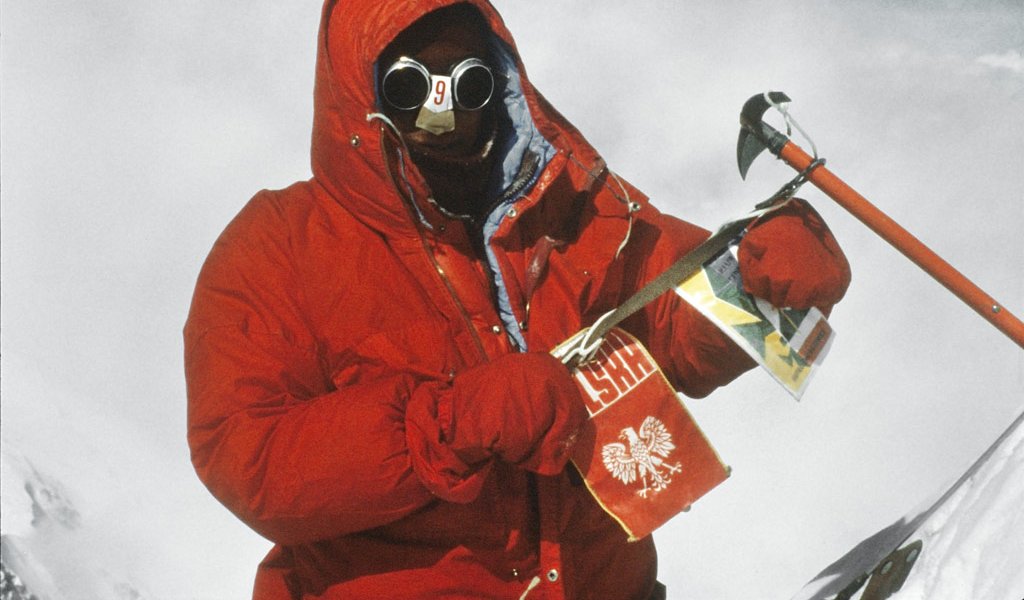Remembering a Polish mountaineering legend
He was the second person in the world to climb all 8,000 metre peaks, the majority of which he scaled using virgin routes, some of them even during winter. Jerzy Kukuczka, who died on 24 October 1989 while climbing the Lhotse, remains one of the most fascinating figures of mountaineering, in Poland as well as around the world.
The only person to climb the crown of the Himalayan and Karakoram mountain ranges, that is all fourteen 8,000 metre peaks, before Kukuczka was Reinhold Messner, an Italian from South Tyrol. It took him 16 years. Using his alpine climbing style, a style which he pioneered, Kukuczka managed to repeat this feat in half the time that it took Messner, despite having fewer resources and less money at his disposal.
Kukuczka climbed 11 peaks using new routes, seven using the alpine style and three during winter. At the time, just applying for a passport in Communist Poland could often take months. In order to raise money for his journeys and equipment, Kukuczka started working in Katowice-based mines, renovating chimneys. “By the time Jurek (ed. the Polish diminutive for Jerzy) climbed his first 8,000 metre peak, Messner had already climbed six. Fame and money made it easier for him to organize each trek, while during Communism Jurek didn’t have anything apart from his passion, his unbelievable strength of character and his ability to survive in the harshest of circumstances,” Piotr Pustelnik recounts in the documentary film “Broken Rope” (“Zerwana Lina”). In 2010, Pustelnik repeated Kukuczka’s achievement of climbing all 14 eight-thousanders.

To this day, Kukuczka remains a fascinating figure. The climber’s widow, Cecylia Kukuczka (who goes by the name Celina), is reminded of this fact by the huge number of tourists who visit the Jerzy Kukuczka Memorial Chamber in Istebna, which she set up in the 1990s in the couple’s former summer house. People from all over the world, young and old, come to see photographs from the peaks of Nanga Parbat, K2, Kangchenjunga as well as plaques taken back as souvenirs (including one from Shisha Pangmy in 1987), a plate with a Mount Everest 1980 logo, pennants, prizes and national awards. All these items tell the story of a boy from Katowice who started off as a weight lifter before, aged 17, becoming fascinated by the Tatra mountains – leading him to later climb the Himalayas.
Visitors take photos and ask questions, such as how did Kukuczka prepare for expeditions and was he intimidated by the fame of the rich and powerful Messner. Celina Kukuczka answers all questions with great patience. “She keeps the memory of her husband alive with unwavering determination. Irrespective of how many people are interested – whether it is one person or ten – she talks them through the Jerzy Kukuczka Memorial Chamber during her 30 minute tours,” Paweł Wysoczański, the director of the film “Jurek” (2015) tells Polska.pl. The documentary has picked up the main awards at the mountain film festivals in Vancouver and Bratislava and received gleaming reviews at the Reykjavik festival in Iceland as well as the audience award at the Gdansk Doc Film Festival in June. It also received a distinction at the Grand Prix 11 Zakopane Mountain Film Festival.
 During the three years that it took to make the film, over 100 hours of interviews with 52 people was collected. The footage that didn’t make it into the 80-minute documentary was given to Jerzy’s son, Wojciech Kukuczka, a graduate of the Academy of Fine Arts who set up a Jerzy Kukuczka Virtual Museum (jerzykukuczka.pl) in December 2014. The website allows fans of the climber to learn more about his life through an interactive combination of graphics, text and sound, compiled from archival video footage, press articles and anecdotes provided by his relatives, friends and fellow climbers. Each 8,000 metre peak climbed by Kukuczka is given its separate section and the collection is still being added to with photos, recordings and stories supplied by mountain enthusiasts. Kukuczka died when his son Wojciech was only four years old. When his father fell from the slopes of the Lhotse, Wojciech remembers being woken up by a nightmare in which he and his father were trapped in a rapidly falling elevator. Years later, Wojciech himself climbed Mount Everest – although he says that he doesn’t share his father’s mountaineering ambitions. In interviews he says that he did not create the museum in his father’s honour purely out of emotion.
During the three years that it took to make the film, over 100 hours of interviews with 52 people was collected. The footage that didn’t make it into the 80-minute documentary was given to Jerzy’s son, Wojciech Kukuczka, a graduate of the Academy of Fine Arts who set up a Jerzy Kukuczka Virtual Museum (jerzykukuczka.pl) in December 2014. The website allows fans of the climber to learn more about his life through an interactive combination of graphics, text and sound, compiled from archival video footage, press articles and anecdotes provided by his relatives, friends and fellow climbers. Each 8,000 metre peak climbed by Kukuczka is given its separate section and the collection is still being added to with photos, recordings and stories supplied by mountain enthusiasts. Kukuczka died when his son Wojciech was only four years old. When his father fell from the slopes of the Lhotse, Wojciech remembers being woken up by a nightmare in which he and his father were trapped in a rapidly falling elevator. Years later, Wojciech himself climbed Mount Everest – although he says that he doesn’t share his father’s mountaineering ambitions. In interviews he says that he did not create the museum in his father’s honour purely out of emotion.

Ever since he was a child, the director Paweł Wysoczański has been fasinated by Kukuczka. One of his main principles that he sticks to when making films is not to hurt the protagonist, but not to idealise them either. This was also the case with this film. “Jurek” shows Kukucza with all his human faults and stumbles that even a hero can experience in his lifetime. Not only does the film tell the story of the famous climber, it also depicts the life of a boy who was passionate about sport and geography. He discovered his love for climbing aged 16 while rock climbing and, two years later, did a Tatra climbing course. The man admired by generations of Tatra mountaineers was close to quitting climbing when his friend and first climbing partner, Piotr Skorupa, died in 1971.
They attempted to scale Kazalnica’s direttissima (a direct climb to the summit of a mountain up the fall line from the valley base to the top), regarded as one of the most difficult routes in the Tatra mountain range. A frozen rope led his partner to fall to his death. Despite serious doubts about whether to continue, Kukuczka decided not to quit mountaineering. After conquering the Tatra mountains he decided to set his sights higher – although his early attempts were not as easy as he would have hoped. In 1974, during his first climb up McKinley (now the Denali), the highest summit in North America, he was beaten by altitude sickness. As if this wasn’t enough, he also lost one of his toes to frostbite during the expedition. Despite these setbacks, Kukuczka proved his ability to climb the world’s highest peaks when, together with Andrzej Czok, he reached the summit of the 8,000 metre high Lhotse on the Chinese-Nepalese border without using oxygen supplies. The same mountain would later claim his life, on 24 October 1989.
The story of Jerzy Kukuczka is also a story of Poland. During the tough days of Communism, he showed how political obstacles and organisations can be overcome with a strength of character and a dogged determination. That is why he contines to inspire film directors and climbers alike.
KAROLINA KOWALSKA
12.01.2016







